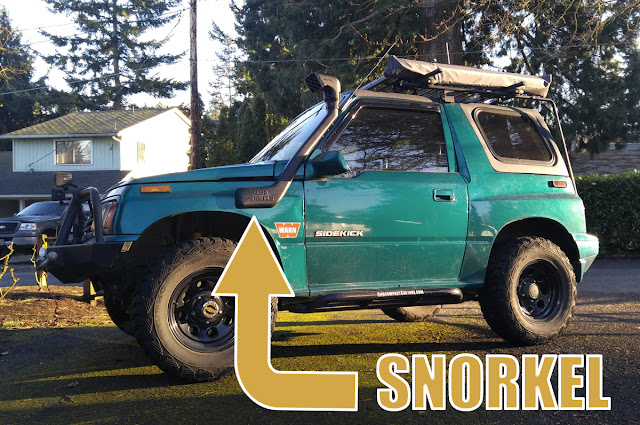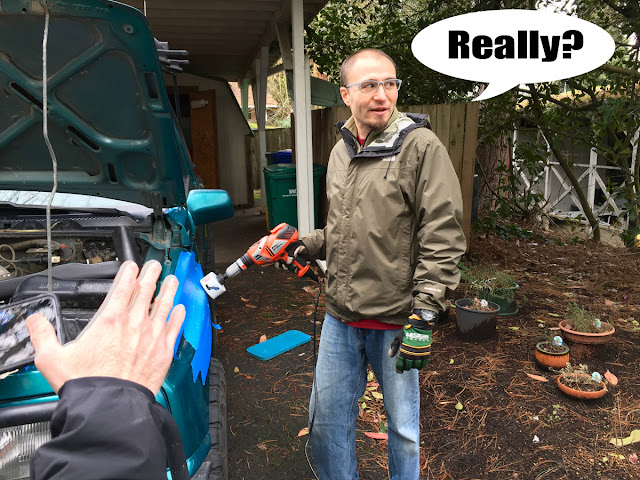Snorkel (noun) snor·kel \ˈsnȯr-kəl\: A tube housing air intake for an engine that can be extended above the water's surface so that the engine can be operated while the Teal Terror's engine is submerged. Yes, we installed a snorkel on the Sidekick. Why? Because it's awesome, that's why! Well, there are actually practical reasons, too.
A snorkel on a 4x4 looks pretty neat, but it's more than just looks. It extends up high so as to not suck water into the engine in deeper water. Now, you'd have to be in some pretty deep water to suck air into the engine, right? I'd say at least four feet or so. What's the likelyhood that'd happen? Probably low. However, sometimes it's better to have it and not need it than need it and not have it. I will say that while at the Off Road Play Area of the Tahuya State Forest Trail System in Washington state, we ran into some deep water. We did go though it, but only after watching a few other vehicles go though. However, it made us think: If we had a snorkel, it'd be one less thing to worry about when off roading.
Fast forward a few months, I decided a snorkel would be a nice accessory for the Sidekick. The unit I got is a Safari Snorkel, which is sold through ARB USA. They're made in Australia, fit right, and are very high quality (as are most ARB parts). The installation, while fairly easy, can be a bit nerve wracking because you need to drill a huge-ass hole in your vehicle's fender. While the phrase "measure twice, cut once" might be great for some things, when you're cutting a giant hole in your car, it's more like measure 97 times, cut once. Luckily, the Safari Snorkel comes with a good set of instructions. Plus my buddy, Isaac, who runs a Safari Snorkel on his 2015 Toyota 4Runner, and has done several snorkel installations, was there to help.
Firstly, we removed the Sidekick's fender liner—easy peasy. While the instructions do not call to remove the fender itself, we did to make things easier (it's only a few bolts). Next, we pulled out what Aussies apparently call the "boom bottle," which is the part of the intake that's essentially made to quiet any intake noises down. The boom bottle is rather huge and resides behind the fender on the Sidekick. And frankly, I'm not sure how you'd remove it without removing the fender. So after removing it, we pulled off the tube that goes to the airbox, which will help us with the installation.
After pulling the boom bottle, we reinstalled the fender then applied painter's tape in case I slipped with the drill bit or anything—just a little extra precaution.
We affixed the included cardboard template to the correct area. We marked the soon-to-be-drilled holes with a Sharpie, pulled the template off, and drilled the four holes that'll hold the snorkel to the fender, starting with small drill bits and gradually stepping up.
To drill the main hole for the snorkel, ARB recommends an 86mm hole saw with an arbor, which is a drill bit that comes out of the saw's center. I could not find an 86mm saw, so I went with an 83mm version, which would prove to be plenty big.
OK, things are getting serious. Am I really going to cut a 3.25-inch hold in my truck?
Yes, really.
Before just going for it, I started with a smaller bit than the hole saw's arbor, just to be on the safe side. OK, well, here goes ...
As I pressed the hole saw into the fender, it immediately grabbed the sheet metal, torquing then stalling the drill. The cutting isn't nearly as smooth as I'd thought; it's not like going into wood where it just kind of bites in slowly and goes. The hole saw's teeth grab aggressively to the sheet metal. You have to go in bursts until it eventually goes though, as witnessed by my buddy Marlon's video. And yes, that's him getting excited in the background.
In all honesty, it wasn't as bad as I thought. It's kind of like going in for surgery. You worry about it a lot, but after it's all done, it really wasn't all that bad. Then again, I guess it depends on the surgery.
Next up, I deburred the holes with a Dremel tool, and touched up the bare metal areas with touch-up paint to inhibit rust. Then, off came the painter's tape.
Next, we measured, marked, and drilled the four holes for the support bracket that goes onto the window pillar. This is a crucial area to get right since there isn't much room for error—it's got to fit right. After drilling the holes, we inserted plastic hole plugs, then screwed stainless bolts into the plugs.
We test-fit the snorkel, ensuring everything lined up right. Thankfully, our formula of "measure 97 times, cut once" seemed to work out well. We began securing the snorkel in place, starting with the four bolts in the fender, then moving up to the bolts that secure the snorkel's upper portion. We used a little bit of thread lock to prevent the bolts from backing out.
Once everything was bolted up, it was time to attach the snorkel to the factory airbox. Since the whole idea behind having a snorkel in the first place is to be able to go though deep water and not suck in water into the airbox, it is necessary to seal the intake tubes joints with silicone to prevent water ingress. We smeared a thick layer of aquarium-grade silicone on the connections to ensure a watertight fit. And since the silicone requires 12+ hours to cure, we braced the intake tubes to prevent any movement at let it sit overnight.
Finally, we installed the upper intake portion using the supplied hose clamp, and reinstalled the fender liner. BOOM—our Safari Snorkel installation was complete. It was actually easier than I thought, but it does require a good bit of attention to detail. Big thanks to Isaac, Marlon, and Mercedes for their help with the install, the photos, and the video.
There are many Safari Snorkel applications for vehicles big and small. My friend Isaac's Toyota 4Runner, as seen above, also has a Safari Snorkel and it serves the same purpose.
Since we removed the "boom bottle" silencer, the Sidekick has a nice bit of intake noise, kind of like a cold air intake. It'll be interesting to see if it helps fuel economy at all, or if it's affected at all.
Whether we decided to ford a river or not, it's a nice little bit of insurance knowing that if the water gets high, we'll be able to make it through. And while the interior might be flooded, our engine won't be.









No comments:
Post a Comment